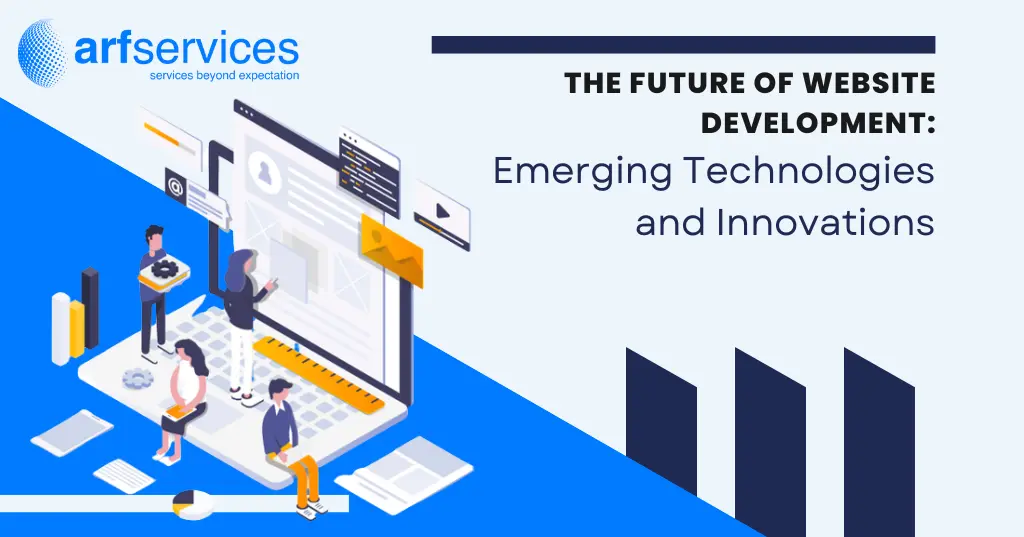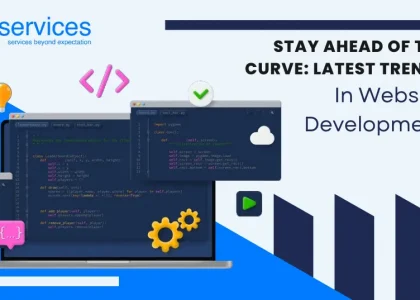The field of web development is dynamic and ever-changing, requiring professionals to stay updated with the latest trends and technologies to remain competitive. As we progress into the future, the possibilities for web development are boundless.
In this post, we will explore emerging trends and technologies that are shaping the future of web development. We will delve into topics such as Artificial Intelligence, Virtual Reality, Progressive Web Applications, and Serverless Architecture. This comprehensive discussion will provide insights into what lies ahead and the implications for programmers, companies, and consumers alike.
Whether you are an expert or a newcomer in the field, get ready to discover what the future holds for web development. Stay informed and embrace the exciting advancements that await us in this ever-evolving sector.
Web Development In The Digital Age
The significance of web development lies in its ability to provide a robust platform for connecting with a global audience. A well-designed website can establish a strong online presence, attract new clients, and facilitate business expansion. Moreover, web development has paved the way for the creation of numerous web-based applications that have revolutionized the way people interact.
Web development plays a crucial role in the democratization of information, enabling the sharing of knowledge and ideas. With the advent of social media and online collaboration tools, web development has empowered individuals to communicate and collaborate on a global scale.
As we progress further into the digital era, web development will continue to be a vital component of the internet and its ecosystem. The future of website development will be shaped by emerging technologies and innovations, each bringing its own advantages and challenges. Success in the digital era will depend on one’s ability to adapt to these changes and leverage the latest advancements.
It is essential for businesses and individuals to embrace the evolving landscape of web development and harness its potential for growth and innovation.
The Technologies and Trends Ruling the Future of Web Development
Web development is a dynamic field that constantly witnesses the emergence of new technologies and trends. These innovations and trends have a profound impact on how web applications are created, enhancing their effectiveness, engagement, and usability.
To stay competitive in the digital era, it is crucial for web developers to stay abreast of the latest developments in web development and incorporate these new technologies and trends into their work.
The following are some of the new trends and technologies that are influencing how we develop websites in the future:
Artificial Intelligence (AI)
Artificial Intelligence (AI) involves the creation of computer systems capable of performing tasks that typically require human intelligence. In the context of web development, AI has significant implications, offering new possibilities for creating personalized, intelligent, and efficient online applications.
Here are some applications of AI in web development:
- User Personalization: AI can analyze user behavior, preferences, and interests to provide tailored content, suggestions, and search results. This enhances the user experience and increases engagement.
- Chatbots: AI-powered chatbots can assist website visitors by answering frequently asked questions, resolving common issues, and facilitating seamless navigation. They provide instant and efficient customer support.
- Content Generation: AI algorithms can generate content automatically, including news stories, product descriptions, and social media posts. This streamlines content creation processes and saves time.
- Performance Optimization: AI can optimize websites and online applications for improved performance. By analyzing data, AI algorithms can identify trends, forecast outcomes, and uncover patterns, allowing for targeted optimization strategies.
The integration of AI in web development offers opportunities to enhance user experiences, automate tasks, and improve efficiency. By leveraging AI capabilities, developers can create intelligent and personalized web applications that adapt to user needs and provide advanced functionalities.
Virtual and Augmented Reality (VR/AR)
Immersive technologies like virtual reality (VR) and augmented reality (AR) have revolutionized the way users interact with digital content, offering more engaging and interactive experiences.
Here are some applications of VR and AR in the future of web development:
- Virtual Showrooms: VR can be used by online businesses to create virtual showrooms, allowing shoppers to visualize products in a 3D environment before making a purchase. This enhances the shopping experience and helps customers make informed decisions.
- Training Simulations: AR can provide immersive and interactive training scenarios for industries such as manufacturing, construction, and healthcare. Employees can learn and practice in realistic virtual environments, enhancing their skills and knowledge.
- Product Demonstrations: VR and AR can be utilized to create compelling product demonstrations, offering buyers a unique and unforgettable experience with a product. This can increase engagement, boost sales, and differentiate brands from competitors.
- Augmented Real-World Information: AR can overlay digital information onto real-world monuments, attractions, or locations, providing users with additional context and enhancing their understanding and experience.
- Virtual Tours: VR can offer virtual tours of popular tourist spots, allowing users to explore and experience different locations from the comfort of their own homes. This can be particularly valuable for remote or inaccessible destinations.
- Gaming Experiences: VR and AR have transformed the gaming industry by providing more immersive and interactive gameplay. Users can engage with virtual worlds and characters in a way that feels realistic and captivating.
As VR and AR technologies continue to evolve, web developers can leverage these immersive technologies to create unique and captivating user experiences across various industries. The integration of VR and AR in web development opens up new possibilities for engagement, education, and entertainment.
Progressive Web Apps (PWA)
Progressive Web Applications (PWAs) are online apps that combine the best features of standard web pages and native mobile applications, offering users a seamless and enhanced user experience. Developed using web technologies like HTML, CSS, and JavaScript, PWAs can function across various platforms and devices, including PCs, tablets, and smartphones.
Here are some use cases of PWAs:
- E-commerce: PWAs can provide customers with a fast and convenient way to make online purchases. Users can explore products, make transactions, and receive notifications about deals and promotions, enhancing the overall shopping experience.
- Offline Functionality: PWAs can serve the most recent news and media content even when users are offline. This ensures that users can access relevant information and media even in areas with limited or no internet connectivity, providing a more satisfying and reliable experience.
- Financial Services: PWAs can offer secure and reliable access to financial services such as banking, investing, and money transfers. Users can perform financial transactions, access account information, and manage their finances conveniently and securely.
- Travel and Booking: PWAs can provide users with a personalized and convenient travel experience. Users can book flights, accommodations, and rental vehicles, access travel information, and receive alerts about cancellations and delays, making their travel planning and management more seamless.
PWAs offer the advantage of being easily accessible through web browsers while providing app-like functionality and performance. Their ability to work across multiple platforms and devices makes them a versatile solution for businesses looking to deliver engaging and responsive user experiences.
Voice Search and Chatbots
With the increasing demand for convenient and personalized digital experiences, voice search and chatbots have gained significant popularity. Voice search has become a common method for consumers to interact with technology, thanks to the rise of smart speakers and virtual assistants. Similarly, organizations are turning to chatbots to provide round-the-clock customer service and automate repetitive tasks.
Here are some use cases for chatbots and voice search in web development:
- Voice Search: Integrating voice search in web development allows users to conduct information searches using natural language, enhancing the usability and accessibility of websites. Users can simply speak their queries, making it easier and more convenient to find the desired information.
- Chatbots: Chatbots can be employed to increase customer engagement and support by providing prompt answers to frequently asked questions and guiding users through the website or product offerings. They can assist users in finding specific items, making purchases, and tracking orders, enhancing the e-commerce experience.
- Lead Generation: Chatbots can also play a role in lead generation by qualifying leads and collecting contact information from potential clients. They can engage in personalized conversations, gather relevant data, and assist in converting leads into potential customers.
Both voice search and chatbots contribute to creating more interactive and user-friendly web experiences. By leveraging these technologies, businesses can enhance customer satisfaction, improve engagement, and streamline their operations.
Serverless Architecture
In a serverless architecture, the cloud service provider manages the infrastructure and handles resource allocation and scaling, eliminating the need for developers to manage servers or worry about infrastructure maintenance. This allows developers to focus on writing and delivering code, resulting in reduced operating costs, improved scalability, and increased development productivity.
Here are some use cases for serverless architecture in web development:
- Backend APIs: Serverless architecture is ideal for building and deploying backend APIs that can handle heavy traffic loads and automatically scale based on demand. This ensures optimal performance and reliability for APIs serving a large number of users.
- Data Processing: Serverless systems can be utilized for data processing tasks, such as input, processing, and transformation. Developers can leverage serverless architecture to efficiently handle data processing functions without having to manage and provision servers.
- Web Applications: By adopting serverless architectures, web applications can automatically scale and handle high traffic loads. This allows websites to provide a seamless user experience even during peak times, without the need for manual scaling or infrastructure management.
- Chatbots: Serverless architectures are well-suited for building chatbots that can perform natural language processing and respond to user inquiries. The serverless model allows chatbots to efficiently handle user interactions and provide real-time responses, enhancing the overall chatbot experience.
- Microservices: Serverless architectures enable the deployment and management of microservices that can interact and scale independently based on demand. This flexibility allows developers to build modular and scalable applications, where each microservice can be independently developed, deployed, and scaled as needed.
By leveraging serverless architecture, businesses can benefit from increased agility, cost efficiency, and scalability, ultimately enhancing their web development capabilities.
The Future of Web Development – Conclusion
New technology and emerging trends are shaping the future of website development. Among these trends, voice search, chatbots, and serverless architecture are key areas to keep an eye on. These technologies offer significant advantages for businesses, including improved user experiences, cost savings, and scalability.
Voice search and chatbots are transforming how users interact with technology, providing personalized and convenient digital experiences. Voice search allows users to easily find information using natural language, while chatbots offer 24/7 customer support and automation of repetitive tasks. These technologies enhance user satisfaction, brand loyalty, and sales by simplifying information retrieval, making purchases, and obtaining assistance.
Serverless architecture is another important trend in website development. By eliminating the need for server management and infrastructure maintenance, serverless architecture allows developers to focus on writing and delivering code. This results in lower operating costs, enhanced scalability, and increased development productivity. Serverless architecture enables businesses to build and deploy applications that automatically scale based on demand, ensuring optimal performance and cost-efficiency.
Overall, these evolving technologies have the potential to greatly impact users and businesses by providing more personalized and seamless digital experiences. As organizations adopt these trends, they can expect improved customer satisfaction, increased brand loyalty, and greater success in the digital landscape. It is important for developers and businesses to stay updated on these trends and leverage them to stay competitive in the future of website development.
Check Out Our Web Development Packages and SEO Packages.








